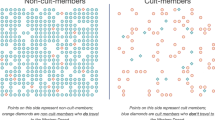Abstract
This paper attempts to find the optimal level of the burden of proof needed in criminal cases in order to minimize crime. It also aims to provide an explanation for the higher burden of proof required in criminal cases than civil cases. It assumes that police officers receive incentive payments for convictions in cases they investigate. Although the direct effect of a higher burden of proof requirement is to reduce the probability of conviction, the indirect effect is to force police officers to build stronger cases and put more effort into finding suspects who are more likely to be guilty. Moreover, the increase in the marginal probability of conviction potential criminals face when they actually commit a crime increases. These factors imply that a reduction in the burden of proof will not necessarily reduce crime.
Similar content being viewed by others
References
Andreoni, J. (1991). “Reasonable Doubt and the Optimal Magnitude of Fines: Should the Penalty Fit the Crime?” Rand Journal of Economics. 22(3), 385–395.
Becker, G. S. (1968). “Crime and Punishment: An Economic Approach.” Journal of Political Economy. 76(2); 169–217; reprinted in R. Febrero & P. S. Schwartz (eds.), The Essence of Becker, Stanford: Hoover Institution Press, 1995.
Becker, G. S. & G. J. Stigler. (1974). “Law Enforcement, Malfeasance, and Compensation of Enforcers.” Journal Legal Studies 3(1), 1–18, reprinted in R. Febrero & P. S. Schwartz (eds.), The Essence of Becker, Stanford: Hoover Institution Press, 1995.
Benson, B. L., Kim, I. & Rasmussen, D. W. (1994). “Estimating Deterrence Effects: A Public Choice Perspective on the Economics of Crime Literature.” Southern Economic Journal. 61(1), 161–168.
Benson, B. L., Kim, I. & Rasmussen, D. W. (1998). “Deterrence and Public Policy: Tradeoffs in the Allocation of Police Resources.” International Review of Law and Economics. 18, 77–100.
Benson, B. L., Kim, I., Rasmussen, D. W. & Zuehlke, T. W. (1992). “Is Property Crime Caused by Drug Use or By Drug Enforcement Policy?” Applied Economics. 24, 679–692.
Benson, B. L., Rasmussen, D. W. & Sollars. D. (1995). “Police Bureaucracies, Their Incentives, and the War on Drugs.” Public Choice, 83, 21–45.
Block, M. K. & Lind, R. C. (1975a). “Crime and Punishment Reconsidered.” The Journal of Legal Studies 4, 241–247.
Block, M. K. & Lind, R. C. (1975b). “An Economic Analysis of Crimes Punishable by Imprisonment.” Journal of Legal Studies. 4, 479–492.
Blumberg, A. S. (1970). Criminal Justice, Chicago: Quadrangle Books.
Bureau of Labor Statistics. U.S. Department of Labor. (2002). Occupational Outlook Handbook, 2002-03 Edition.
Dilulio, J. J. (1996). “Help Wanted: Economists, Crime and Public Policy.” Journal of Economic Perspectives. 10(1), 3–24.
Ehrlich, I. (1996). “Crime, Punishment and the Market for Offenses.” Journal of Economic Perspectives. 10(1), 43–67.
Ehrlich, I. (1982). “The Optimum Enforcement of Laws and the Concept of Justice: A Positive Analysis.” Inter-national Review of Law and Economics. 2, 3–27.
Farmer, A. & Terrel, D. (2001). “Crime Versus Justice: Is There a Tradeoff?” Journal of Law and Economics. 44(2), 345–366.
Franzoni, L. A. (1999). “Negotiated Enforcement and Credible Deterrence.” The Economic Journal. 109, 509–535.
Friedman, D. (1999). “Why Not Hang Them All: The Virtues of Inefficient Punishment.” Journal of Political Economy. 107, S259–S269.
Glaeser, E. L., Kessler, D. P. & Peihl, A. M. (1998). “What Do Prosecutors Maximize?: An Analysis of the Federalization of Drug Crimes.” American Law and Economics Review. 2(2), 259–290.
Jellal, Mohamed & Nuno Garoupa. (1999). “Optimal LawEnforcement Under Asymmetric Information,” Working paper, Universitat Pampeu Fabra.
Lando, Henrik. (2000). “The Optimal Standard of Proof in Criminal Law When Both Fairness and Deterrence Matter,” Manuscript, Copenhagen Business School.
Mas-Colell, A., Whinston, M. D. & Green, J. R. (1995). Microeconomic Theory, Oxford University Press.
Mast, B. D., Benson, B. L. & Rasmussen D. W. (2000). “Entrepreneurial Police and Drug Enforcement Policy.” Public Choice. 104, 285–308.
Miceli, T. J. (1990). “Optimal Prosecution of Defendants Whose Guilt is Uncertain.” Journal of Law, Economics, and Organization. 6(1), 189–201.
Posner, R. A. (1999). “An Economic Approach to the Law of Evidence,” Working Paper no.66, University of Chicago.
Posner, R. A. (1992). Economic Analysis of Law, 4th ed, Boston: Little, Brown and Company.
Reinganum, J. F. (1993). “The Law Enforcement Process and Criminal Choice.“ International Review of Law and Economics. 13, 115–134.
Roberts, J. (1998). “Plea Bargaining and 'Truth-Telling', Manuscript, Queen's University.” Shavell, S. (1991). “Specific Versus General Enforcement of Law.” Journal of Political Economy. 99(5), 1088–1108.
Shavell, S. (1993). “The Optimal Structure of Law Enforcement.” Journal of Law and Economics. 36, 255–287.
Stigler, G. (1970). “The Optimum Enforcement of Laws.”Journal of Political Economy. 78, 526–536.
Thornton, G. C. & Morris, D. M. (2001). “The Application of Assessment Center Technology to the Evaluation of Personnel Records.” Public Personnel Management. 30(1), 55–66.
Waldfogel, J. (1993). “Criminal Sentences as Endogenous Taxes: Are They “Just” or “Efficient”? Journal of Law and Economics. 36, 139–151.
Author information
Authors and Affiliations
Rights and permissions
About this article
Cite this article
Pyne, D. Can Making It Harder to Convict Criminals Ever Reduce Crime?. European Journal of Law and Economics 18, 191–201 (2004). https://doi.org/10.1023/B:EJLE.0000045081.01565.ed
Issue Date:
DOI: https://doi.org/10.1023/B:EJLE.0000045081.01565.ed




